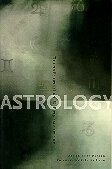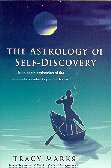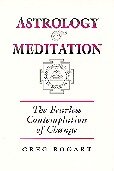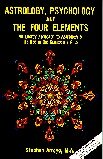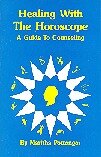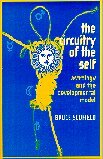Contents: Introduction: Comparing astrology with pyschology; Scientific model building
1. Where is the person in the astrological chart? The limits of psychology; The common sense of human nature; The multiple selves; Planets as a map of the self
2. The mapping of the self: Self, ego & personality; Identity, soul & psyche; The modern psychoanalytic map of the self; The biological perspective; Caveman consciousness; Temperament
3. Instincts, emotions & biological rhythms: Instincts & imprint vulnerability; Emotions & the biological imperative; Circadian cycles & lunar periodicities
4. The developmental model: Freud; Rudolf Steiner's developmental stages; Erik Erikson's Freudian extension; Piaget's developmental model of learning; Building on Piaget & Freud; Comparing developmental models; Timothy Leary & Robert Anton Wilson
5. Astrology & the developmental model: The role of the sun; Giving up the ego; The inner planets; An explanation for astrology; The outer planets; Other factors in the birth chart
6. The lunar bio-survival stage: The lunar world of babies; The moon in traditional astrology; Lunar imprinting; The lunar aspects
7. The Mars circuit of individual power & autonomy: The Mars imprint; Mars & other planets
8. The Mercury circuit: Learning & language: Piaget's theory of learning; Cycles of Mercury; Mercury & the other planets
9. The Venus socio-sexual circuit: The cycles of Venus; Love, sex, fashion & culture; The aspects of Venus
10. Jupiter & Saturn: Planets of socialization & culture: Socialization & enculturation; Jupiter contacts with other planets; Saturn contacts with other planets; Reaching maturity & adulthood
11. The outer planet higher octave circuits: Neptune, Pluto, Uranus; The Neptunian holistic circuit; Neptune & the other planetary circuits; The Plutonian power-generating circuit; Pluto & the other planetary circuits; The Uranian conceptual circuit; Uranus & the other planets; The 8th non-local consciousness generating circuit
12. Epilogue
References
Comment: The author thinks I have been unfair in my previous remarks, so he has caused me to concentrate my efforts. I am not certain he will be more pleased with the results.
The Developmental Model has to do with how children grow up. They go through stages. Which, strictly speaking, are based on their individual natal charts (of course!) but only if you can read them in detail, which most astrologers cannot.
Therefore many generalizations are made. The "terrible twos," for example. Classical astrology accounts for this in the Ages of Man, which Ptolemy gave to the planets, starting with the Moon at birth and continuing, based on speed. The Moon rules from birth to age 4, Mercury rules from 4 to 14, Venus rules from 14 to 22, etc.
Not understanding this, or perhaps thinking they have a better idea, modern psychologists have proposed various other systems with various other timelines. Scofield surveys these in chapter 4, The Developmental Model.
He ends that chapter with his favorite of the modern systems, the Eight Circuit Model of Timothy Leary (1920-1996) and Robert Anton Wilson. Leary is famous for his work with LSD in the 1960's, before it was outlawed. Leary also advocated Transhumanism, which is the (revolting) idea that one can live forever. (This is revolting in part because, as one ages, he and his chart become more and more out of synch with current events. There is no solution for this. Even the Church, the oldest single institution in existence, is showing its cracks.) As Transhumanists do not believe in souls (which I myself can easily demonstrate, merely by liberating one in distress and watching that release bring everyone in the room to tears), Transhumanists are unaware of the advantages of dropping an aging body and reincarnating in a sexy new one. Wiki says the Eight Circuit Model was taken from an Indian source, but Wiki is silent as to exactly what that source was. Leary's theory was designed to incorporate various earlier psychological theories into it.
Robert Anton Wilson, 1932-2007, was known primarily as an avante-garde novelist. He had many interests.
On to the theory itself, which in this book comprises chapters 6-11.
Chapter 6, The Lunar Bio-Survival Stage takes us from birth to age 2. Scofield puts this under the rulership of the moon.
Chapter 7 is The Mars Circuit of Individual Power and Authority. As with the Moon chapter, Scofield does not spend a lot of time on the infant child, but instead focuses on adult expression of Martian energies. As with the previous chapter on the Moon, it includes a section of Mars aspects. It is amusing to compare identical aspects:
Moon-Mars: Security and attachment must be fought for. . . (pg. 113)
Mars-Moon: Autonomy is linked to caring and protection. . . (pg. 123)
Chapter 8 is The Mercury circuit: Learning and Language. The ages that Mercury rules seem to be distinctly vague. In the opening paragraph, Scofield cites ages 1 through 7.
Chapter 9, The Venus Socio-Sexual Circuit. Theorists want to give this a discreet starting point in terms of age, but it actually starts with puberty. There is no discussion of, say, high school, which is supposedly the Venusian period in our lives. The aspect section includes (+) and (-) aspects, which presumably relate to soft or hard aspects.
Chapter 10 is Jupiter and Saturn, Planets of Socialization and Culture. This is an overlapping period, as it seems to start around the age of seven. As befits a murky subject, much of the chapter is taken up in speculation. In the aspect section, we learn the Mercury circuit lasts from 6 to 13. The aspect section does not cover Jupiter aspecting Saturn, nor Saturn aspecting Jupiter. It would be of interest to plot the onset of puberty against the Moon in the various elements.
Chapter 11 is The Outer Planet Higher Octave Circuit. Neptune is the higher octave of the Moon. Some of you will remember Neptune as the higher octave of Venus. I would prefer that we thought of Neptune as Neptune, rather than use crutches like this. In the aspect section, Moon and Neptune may make you a very sleepy fellow.
Pluto is the power-generating circuit. Scofield associates it with Mars, and then apologizes for not linking it with Venus, which is presumably a nod to Jeffrey Green. In this section Scofield discusses death and as he seems to be a Transhumanist, he ascribes past life memories to actual memories transmittted by means of DNA from one generation to another. There is abundant hard evidence to suggest this is wrong, I myself can supply some.
Uranus is the Conceptual Circuit. Scofield sees it as the higher octave of Mercury, which is the traditional view. When it is functioning, it launches the individual into some abrupt change of consciousness. Scofield relates this to Gurjieff's levels of awakening, or to various Zen states. A more practical example might be the sudden awakening that occurs to Jesus Freaks, accepting The Lord as one's personal savior, but Scofield does not mention this.
The 8th and final circuit is the Non Local Conscious Generating Circuit. Scofield does not have a planet to cover this circuit, which, remember, was postulated by Timothy Leary, among others. Leary had different names for the various circuits. His name for the 8th one was Cyber-Nano-Tech Piloting Atomic Info and said that bodies were no longer necessary. Robert Anton Wilson called it Non-Local Quantum Circuit. The description that Scofield gives, to me, are artifacts of common astral projection.
In the Epilogue, Scofield suggests his book can be a model for the scientific testing of astrology. I will always think this backwards. Science is a bathtub. Astrology is the ocean itself. The author is presumably unhappy I do not find this to be a great masterwork. I would suggest he read old science texts. As libraries commonly throw away science books that are 20 years old or older, he should read old collections of science magazines. Unlike astrology, science is intensely faddish. Always has been. Always will be.
There are four blurbs on the back of the book. The author himself has asked me to include them. There is one from a Fellow of the Royal Astronomical Society and another from an associate professor at the University of Massachusetts, neither of which concern us. There are two from noted astrologers, which do. Here they are:
Drawing on his years of experience in counseling clients, Bruce Scofield uses the birth chart as a map of the self to expound a new theory that integrates natal astrology with developmental psychology. I would highly recommend this book to any astrologer intersted in the inner workings of the human psyche. - Anthony Louis, psychiatrist and author of Horary Astrology: The History and Practice of Astro-Divination, and Tarot Plain and Simple
Scofield gives a new and much-needed conceptual framework for astrology that clarifies the interplay of planetary symbolism in the birthchart. This book is a must-read for anyone interested in how the planets are reflected in the structure of the psyche. - "Tem Tarritar" publisher of the The Mountain Astrologer. (Should be Tem Tarriktar - Dave)
Also from the back of the book: BRUCE SCOFIELD, C.A., NCGR, is a professional astrological consultant who works with clients in the United States and abroad. He has authored 12 books, has Level IV certification from the NCGR, and is on the faculty of Kepler College.
One Reed, 191 pages.




